When you’re stuck in place processing trauma, how do you go about fixing your heart rather than dying? This Twin Peaks theory thinks you do it with the tool introduced in the very first non-Lodgespace scene of Season 3: the golden shovel. And I assure you, the two coats(!) are absolutely necessary.
Golden Shovels
 In Part 1 we saw the shovels arrive but didn’t know what they were or where they were going. All we knew by the end of the extended scene was that Jacoby wanted this delivery.
In Part 1 we saw the shovels arrive but didn’t know what they were or where they were going. All we knew by the end of the extended scene was that Jacoby wanted this delivery.
The next time we see the shovels, Jacoby is in his properly protective gear spraying a coat of paint.
Then we finally see Jacoby in his full Dr. Amp glory and we’re laughing our asses off. that’s what the shovels were for??
But then we see more Dr. Amp shows, and we even see the commercial again. And we feel the message in a different light.
Then we see Nadine using the advice in her own life and it bankshots into Ed and Norma getting together.
Think of the feelings evoked in you when you first watched these scenes as we look again at the shovel stages, this time against the thematically similar message of help delivered to Bobby in Major Briggs’ message pod. The pod contains a message which also involves a slow-reveal process just to see the message, and in its way the pod is also a physical microcosm of the path from trauma to understanding:
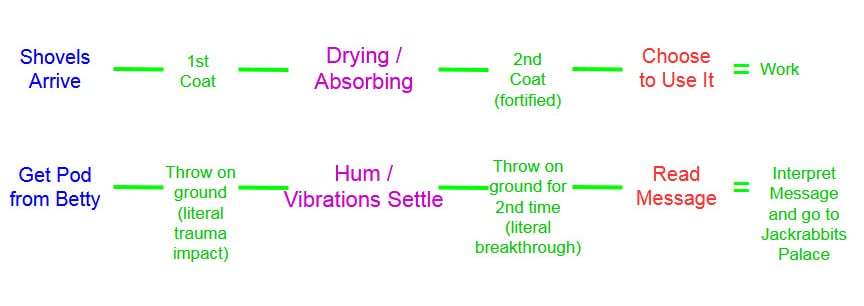
For yet more similarities, let’s line the shovel stages up against Dale’s chronological timeline, as well as the trauma cycle:
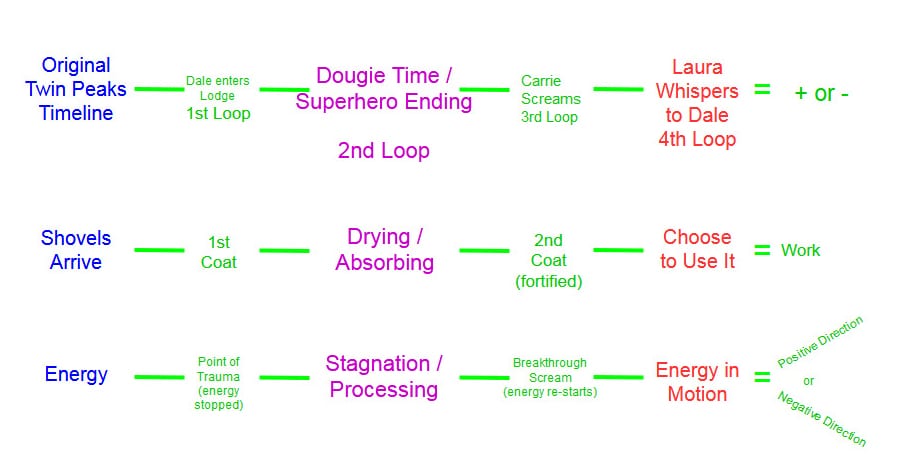
If you use a golden shovel, you choose positive energy. You choose life. You choose to be a traveler.
The process of readying the shovels mirrors how Dr. Jacoby readied himself, including two moves from Twin Peaks to Hawaii placed exactly even with where the shovels would be getting their gold coats:

Jacoby’s reason to first go to Hawaii was because his father was stationed there. He was also separated from his brother and father, who returned to Twin Peaks much earlier than he did. This lines up with a point of trauma, so perhaps the division of his family was an equivalent event in his life.
Eventually, after some spiritual quests (where per The Secret History of Twin Peaks he met a number of creatures that appeared to look like the Fireman) he returned to Twin Peaks, where he tried to help people as a psychologist but ended up not helping Laura Palmer at all. Near the end of SHoTP, as he realizes he’ll probably lose his license to practice, he says this:
But the truth is Laura’s death has broken me. My own belief system—the fantasy that I could hold these worlds in balance—inner life, outer reality—and bring the truth of one closer to the other, like some free-thinking hippie Prometheus, is shattered. What a hapless fool I’ve been. Actions have consequences. Whatever happens from here, whatever the squares decide about my professional fate, if I can survive this ordeal, find the strength to dig my way out of it, I make this vow: no more lies. Only truth. Straight up. To everyone.
This is most definitely Jacoby’s breakthrough point, and the reason he leaves for Hawaii for a second time. This matches up with the second coat, and the point where people scream to restart their stagnant energy.
From this point forward, Jacoby began learning all he could about helping people in multiple studies, and eventually he created his Dr. Amp persona and the golden shovel metaphor. This is how he was going to help. He wanted to help people reach the same conclusion he did: that living within a deception where actions don’t have consequences is not the answer. He needed to dig himself out of the shit. And he wanted to become a proverbial golden shovel to help others start their own process.
If you choose to use a shovel, it looks like this:

Call For Help
Jacoby almost literally became a golden shovel for Nadine. Let’s look at Nadine’s Season 3 arc matched up with the trauma cycle, as well as to the shovels:

Continuing to follow the bankshot, let’s look at how Ed is released by Nadine in Part 15, then goes through his own evolution:

There’s more of this helping pattern than just the straight line from Jacoby’s help. It appears every character connected to the Fireman finds a way to help someone. Carl Rodd, for example, helps the hit and run mom in her moment of need; his compassion frees her from being stuck in a loop of despair. Positive energy directed towards someone else is the help that allows the other person’s energy to begin moving again. And their energy can resume being part of the energy cycle between material and non-material universes or whatever you want to call it.
If I had to explain the full shape of a trauma cycle, it’d look like this:
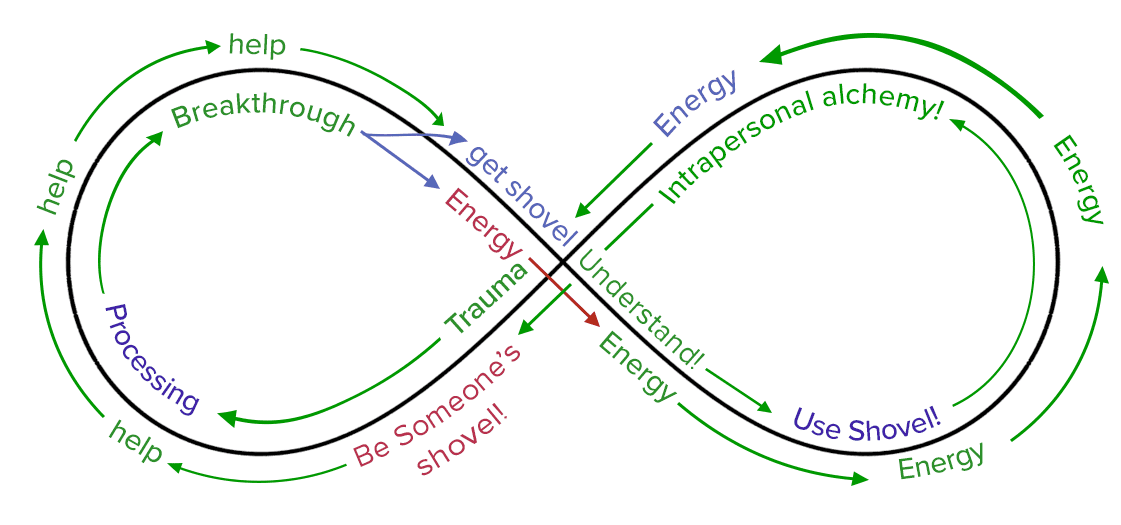
I think Dale, as a full-on magician in Part 17, thinks he’s doing this kind of work:

Except he’s only in loop 3 at the time. He’s only here:

Dale thinks he’s helping, I honestly think that, but he is “far away.” He doesn’t even have his shovel yet. He needs to reach a certain point alchemy-wise to do the kind of magic he’s trying to do. Just like Jack Parson with his Thelema magic and the other ring wearers in Secret History of Twin Peaks, Dale’s hubris is outrunning his alchemic state.
Though really, it doesn’t mean Dale isn’t helping Laura anyway, it’s probably just not how he thinks he’s helping. After all, people being incremental shovelfuls of golden help along the way is exactly how help works in Season 3.Just ask Janey-E
Help, Delivered Incrementally
In Part 4, Lodge symbols hover over slot machines ready to hit jackpots for Dougie. Then Bill and Candy Shaker give him enough info to find where he lives, and Supervisor Burns reluctantly gives him his winnings and authorizes a limo ride home. So this gets Cooper-as-Dougie home to Janey-E, who receives the money and understands that she can pay for all the debts Dougie accrued that caused Janey-E nothing but trauma and stress. She was released by this money and then slowly but surely became more and more present and loving towards Dougie.
Here’s a quote from my Part 4 Rewatch article on the subject:
What we see in this casino portion of Part 4 is a number of small incrementally helpful steps from a number of people, little steps that on their own don’t go too far, that add up to Cooper-as-Dougie arriving at a location he initially didn’t know about with enough money in hand to pay for the previous debts of Dougie Jones. Call for help, indeed.
This is also a microcosm of how the plan to stop DoppelCooper comes together: The Log Lady helps Hawk to the Diary pages, which leads Bobby to the chair, which leads to Andy getting an audience with the Fireman, which leads to Lucy shooting DoppelCooper, which leads to Freddy knocking the BOB orb apart. There are no main heroes in this story, more so many people having smaller moments of heroism that add together into the positive energy that can overwhelm the darkness, or at least, as in the casino scene’s case, bring forth the light to those in need.
Honestly, compassion and everything related to help that Janey-E mentioned in her “we are the 99%” monologue is positive energy, but it’s also rooted in Love, which is called a key that “open[s] the door” back in Season 2. And negative energy can easily be equated with Fear, the other door key.
Sometimes help isn’t enough
Just because help is offered doesn’t mean characters will take the help, though. Just ask Hawk. He offered help to Sarah Palmer and had plenty of compassion when doing so, but the compassion must be accepted. Sarah basically growled at him and closed the door.
Season 3 is made out of choices that can fix your heart, but you can also make choices to—however soon—die. The choices can go in both positive and negative directions. And no better is this on display than the scenes at the Roadhouse.
Characters at the point of a breakthrough use the Roadhouse as a junction point
Not only is the Roadhouse a junction point between realities within the story itself, it is also a junction point of theme. It display three states of reality for us to use as a compass, and it also consistently shows us characters that accept or refuse personal responsibility, thus changing which frequency of reality they exist in.
Each random we’ll-never-see-them-again character in the Roadhouse is either on the precipice of their own breakthrough moment like Audrey, or they’re there—whether to be a golden shovel or more weight—to help someone make a decision to direct their restarted energy positively or negatively.
I look into this more deeply in How The Roadhouse Works in Season 3, but I will explain it concisely here in terms of Cooper’s time loops as the frequencies to tune to. The Roadhouse has the ability to step out into the positive Timeline-adjacent 1st time loop frequency, or into his negative Lodgespace-adjacent 3rd time loop frequency. Which frequency we are shown depends on the establishing shot(s) of each Roadhouse scene.
- The parking lot – tunes to the in-between state (the 2nd Loop)
- The Bang Bang Bar sign – tunes toward the Timeline (by way of the 1st Loop)
- The Sign reflected in a puddle – tunes toward Lodgespace (by way of the 3rd Loop)
- If the parking lot is mixed with one of the signs, I think it connotes a shifting from the Timeline toward the in-between state, or from the in-between state toward Lodgespace.
The Timeline-Adjacent Positive Frequency
Roadhouse scenes that begin with the Bang Bang Bar sign begin with a positive energy frequency. This is tuned to Cooper’s 1st Time Loop.
In Part 2, the parking lot is included in the establishing shot. Shelly and her friends are there as well as James and Freddie, and even Red and his finger guns. It seems like most things are normal, though the Owl Ring is present on the Chromatics’ guitarist, and Shelly voices that possible reversal “James has always been cool.” Why the parking lot along with the sign? As it’s the episode where Dale’s 1st Loop ends and 2nd Loop begins, the symbolic angle could be the tuning from the Timeline officially into the in-between state.
In Part 4, we only see Au Revoir Simone play. They are lit in purple light.
In Part 12, Abbie and Natalie at the booth are looking for Angela, who’s on the edge and off her meds and has been hanging out with (and dreaming of) a two-timer by the name of Clark. Angela’s off-balance and her friends mention she’s dreaming, however literally they mean. Angela’s not there because the bar and the women are tuned towards Loop 1 while Angela’s tuned negatively towards 3rd Loop. The ladies’ friend Trick shows up after almost being in a head-on collision with a car going the wrong way. He’s just out of house arrest, may have experienced a reversal as he arrived to the same positive tuning as his friends. After all, he’s just out of house arrest (a stagnation period) and that’s behind him now. He’s shoveled himself out of the shit. They’re heading to the Timeline.
In Part 14, Sophie is acting like a shovel for her friend Megan, who talks about a time she saw Billy bleeding out of his mouth, but then can’t remember the rest. It’s like she woke up from a dream; like she just stopped tuning towards Lodgespace for good. Right at this revelation, Lissie starts singing triumphantly with a lot of energy and her lighting is only yellow: a state of achieved intrapersonal alchemy personified by a scene, if you ask me.
Part 15 also includes the parking lot. It moves from being tuned towards the Timeline into being tuned in the middle when James and Freddie interrupt the otherwise banal scene of Renee, Chuck and their friends. When it really tunes towards Lodgespace-adjacency? When Freddie uses his glove and the music skips (two punches!). Later on we see a shot of the parking lot, where you could say it’s still tuned to the middle state, but then transitions to tuning towards Lodgespace as Ruby (whose energy is stuck in place as she’s waiting for someone) crawls along the floor and begins screaming (her breaking point) as the strobe light kicks in and it is implied she caves in to Lodgespace.
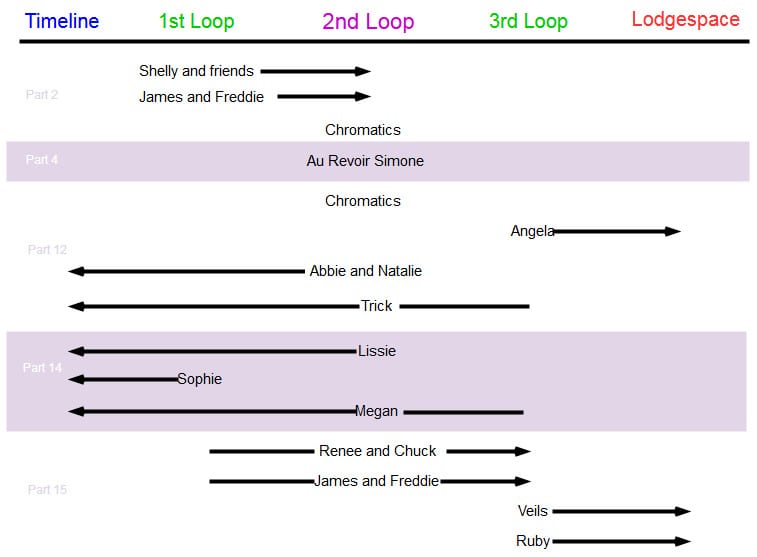
The Lodgespace-Adjacent Negative Frequency
Roadhouse scenes that begin with the Bang Bang Bar sign reflected in the puddle begin with a negative energy frequency. This is tuned to Cooper’s 3rd Time Loop.
When Dale gets lost in the 3rd Loop, he begins to become unrecognizable, known as Richard while Diane is known as Linda. They become part of the well-established name salad (Chuck and Tina and Billy, etc.) that is well on display during these Roadhouse scenes.
Billy is an indicator of Lodgespace presence. He’s not a character per se but he is a landmark as the story proverbially drives through that part of town. The random characters who knew him either choose to step away from his drama, therefore tuning to 1st Loop on their way to the Timeline, or they stay tuned into Billy’s kind of drama towards the 3rd Loop on their way to Lodgespace.
In Part 3, we just see the Cactus Blossoms. They’re lit in blue with yellow lighting behind them, which I’d say is traditionally positive Timeline-leaning imagery. Is the visual code saying that Timeline and Lodgespace tuning exists together all at once?
In Part 5, we see a person walk straight through the reflection. The next thing we see is Richard Horne, so that’s easy to see as code for “we are now entering from the in-between into Lodge-adjacency.” Between his parentage and actions, it’s nearly impossible to argue. How else? The girl and her friends are frozen with inaction even as he threatens vile things I refuse to type here.
In Part 9, we meet Chloe and Ella. Both are talking in sparkle drug code about animals, and rash girl got fired and started the same exact job across the street. Sounds like a reversal that she noticed but didn’t understand, and that the two girls were going to continue this descent into Lodgespace darkness without even comprehending what they’re only barely noticing.
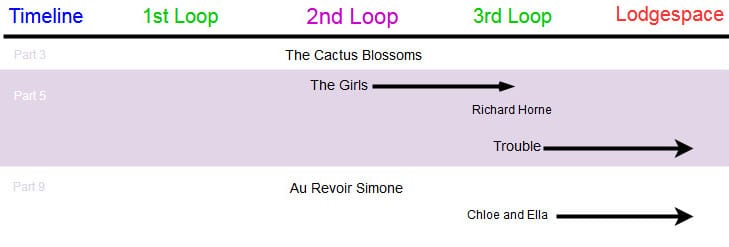
The In-Between Frequency
Roadhouse scenes that begin with the parking lot establishing shot begin with a neutral or stalled state of energy frequency. This is tuned to Cooper’s 2nd Time Loop.
In Part 6, we just see Sharon Van Etton perform. She’s lit in blue and the curtains behind her are a purplish red.
In Part 7, it goes to the sweeping scene where we are likely seeing the Timeline symbolically swept away by the man sweeping the floor (with the red stage curtains looming in the back corner of the shot), clearing the space for what will come starting with Jean-Michele Renault’s call about high school girls, then the diner patron flip in the credits, then what must have always been in Part 8.
In Part 10, the Roadhouse is preceded by the foggy moon. Rebekah Del Rio sings No Stars against purple/red curtains.
In Part 13, James is lit in purple, as if he’s finding his proper balance, and we see Renee crying.
In Part 16, we see Eddie Vedder’s shadow first, then him. The rest of the stage is black except for his spotlight, and there’s some purple curtains in the light. Audrey and Charlie arrive and Audrey toasts to Billy, then dances to her named “Audrey’s Dance” from the original Twin Peaks Soundtrack—a previously-mentioned sign of Timeline presence. This is Audrey being completely tuned to the Timeline, up to and including Eddie Vedder billed as his birth name (rather than the name we all know). Then, a fight breaks out and Audrey begs Charlie to get her “out of here”, and while she is in the white room with the mirror, the Roadhouse plays her song backwards in a full reflection of what they just played. Though Audrey’s frequency is much more complicated—we’ll look into that next—the Roadhouse itself could plausibly be tuned to the 3rd Loop at this point.
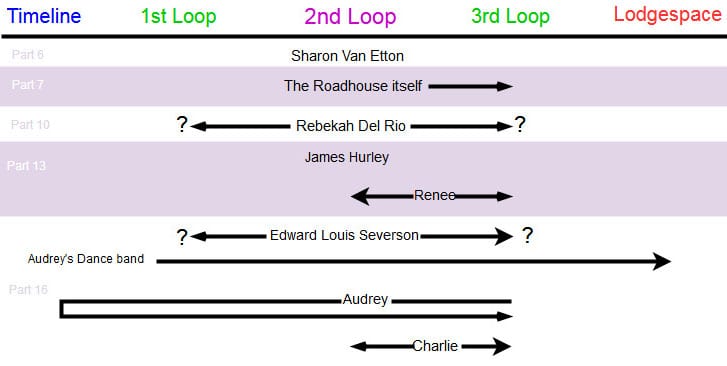




Thanks John!
After reading Dion Fortune’s ‘Psychic Self Defence’ I noticed she writes about the Qaballistic Tree of Life having a double Of itself. It is called the Qlippoth. This Qlippoth is a ‘Mirror’ set of Demonic emanations which are produced from the instability of the sephiroth of the Tree of Life coming into being. This demonic mirror world is the one that Black Lodge magicians work with in their magick. So we have the two worlds here. This is in tune with what you say about the Buddhist viewpoint of two worlds. Thoughtforms are also mentioned in the book – they require part of the original magician or victim’s prana/chi or life force.
Mark Frost has been reported to have used this book along with Talbot Mundy’s ‘The Devils Guard’ in the development of the OG twin peaks.
Sounds perfectly in line! I bet I’ve been accidentally reverse-engineering this stuff…you’ll probably this one from Laura Stewart too. https://25yearslatersite.com/2020/02/14/twin-peaks-the-theosophical-history-of-the-dweller-on-the-threshold/
John this is so well written and thought out. How many times have you seen Season 3?
This is great work! There’s so much depth here that I never picked up on before. I’m intrigued and impressed with your theory and research. I’ve been kind of obsessing over the “Fire Walk with Me” poem for a while, since before I ever saw Season 3, and I have an alternate explanation that I think is in line with your primary thesis but not the exact interpretation that you arrived at: It seems to me that “through the darkness of future past, the magician longs to see” is about the Lodgespace/dream taking over, changing memories and events. “Future past” would normally mean “present”, but in this context it’s an altered present by a “magician” (Lodgespace / negative energy) using “fire” / electricity / magic, as multiple timeline loops overlap with reality. I think that this is the negative energy “longing to” oppose the reality of trauma and the timeline. I agree that “fire, walk with me” can refer to a positive energy breaking stagnation as you suggest, but I think it was most likely intended negatively, as it was originally BOB / Mike’s saying (before Mike cut off The Arm and was still BOB’s partner). Also, I believe that The Fireman (one who puts out fires) is a clear opponent to the forces of evil, solidifying the “fire is evil” motif.
Thanks for your great work here. I’m excited to keep digging deeper! Cheers!